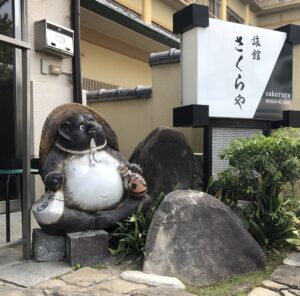

If you’ve been to a Japanese restaurant, you may have encountered this rascal outside the door. Known as a Tanuki this mythical creature is derived from the actual Japanese Raccoon Dog, Nyctereutes viverrinus, which is endemic to Japan. Tanuki are related to foxes, wolves, and domestic dogs, but not to actual raccoons.
Mythological Tanuki have a long history in Japan. They were first associated with the negative aspects of Chinese fox lore. These earlyvTanuki appeared as shape-shifters with supernatural powers who often assumed human form and/or tricked people.
Over time, Tanuki morphed into more humorous tricksters. Contemporary Tanuki portray an image of cheerful, lovable rogues who bring prosperity and business success. In Japan, Tanuki are often found outside restaurants and bars inviting passers-by to join them for a good time inside.
The Tanuki’s Eight Traits
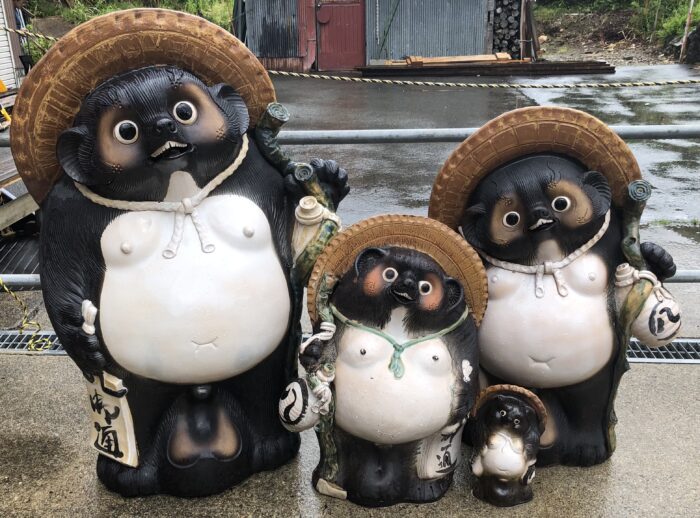
Whether large or small, Tanuki share eight common traits that bring good fortune.
The wide-brimmed lucky bamboo hats offer protection from trouble.The hat refers to a song about a Tanuki who took sake from a brewery on rainy nights.
Large eyes give Tanuki perception and the ability to make wise decisions.
Tanuki have a friendly smile, inviting humans to join them inside the establishment for a good time.
The Tanuki holds a sake bottle in one hand to represent virtue. This could be associated with the same song that introduced the bamboo hat.
The Tanuki has a big tail that gives him the strength to remain steady until success is achieved.
The big belly symbolizes decisiveness. Outside a restaurant, it may indicate good food inside. Not to mention, Tanuki are known for belly-drumming.
The Tanuki holds a promissory note in one hand to demonstrate trust.
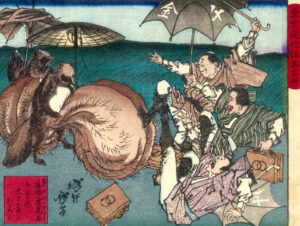
Lastly, Tanuki have very large scrotums which symbolize wealth. You may wonder about the connection between large Tanuki scrotums and wealth. One story says that long ago in Kanazawa Prefecture craftsmen put gold between Tanuki skins or pelts [from the animal] and hammered it flat in order to produce gold leaf sheets. The durable skin allowed workers to stretch the metal to its thinnest point.
Another explanation is that in Japan testicles are referred to as kintama, meaning gold.
In addition to symbolizing wealth, the Tanuki’s scrotum has magical properties. For example, as this woodcut by Yoshitoshi demonstrates, a Tanuki’s scrotum can stretch to any size allowing it, in this instance, to become a boat that rescues people from an overflowing river.
Bunbuku-Chagama — The Magic Tea Kettle
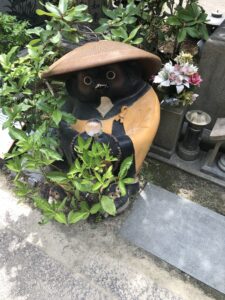
There are numerous legends about Tanuki shape-shifting. This is the story of The Magic Tea Kettle.
A poor man, sometimes said to own an antique store, freed a living Tanuki from a trap. That night, the Tanuki visited the man to thank him. As a token of his gratitude, the Tanuki told the man that the priest at the temple was looking for a tea kettle. The Tanuki said he would disguise himself as a gold tea kettle so the man could sell him to the priest.
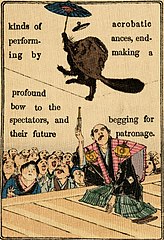
The next day, the man offered the tea kettle to a priest who paid him a high price. The priest gave the kettle to a novice and told him to wash it. As the novice scrubbed it, the tea kettle said “You’re hurting my bottom.” The surprised novice reported what happened to the priest who didn’t believe him.
The priest filled the kettle with water and placed it on the fire to boil. The tea kettle said “It’s hot!” The talking tea kettle surprised the priest. He was more surprised when the kettle returned to its true form as a Tanuki and ran back to the poor man.
The Tanuki still wanted to help the man, so he suggested they go to town together. The Tanuki took the form of the tea kettle again, performed a tightrope walk, drummed his belly, and sang. Everyone was amazed, and the poor man became wealthy by charging admission to this marvelous performance. Over time, the Tanuki remained too long in the form of a kettle and lost its ability to move.
You can hear a somewhat different version of this story, complete with illustrations, in this 9 minute video from the National Museum of Asian Art.
🍵 🍵 🍵
Illustrations
Tanuki outside Sakuraya Restaurant on Miyajima Island by Author.
Tanuki in Higashiyama Zoo by KKPCW.
Four Tanuki in Shirakawa-go, Kanazawa.
Rainy Day Tanuki woodblock by Yoshitoshi. 1881.
Tanuki at Daijanji Buddhist Temple by Author.
Tanuki Kettle Walks Tightrope. 1886.
The Magic Tea Kettle. Public Relations Office. Government of Japan. 2015.
“Mythology of the Japanese Tanuki.” Live Japan. Dec. 2, 2016.

Sandra Wagner-Wright holds the doctoral degree in history and taught women’s and global history at the University of Hawai`i. Sandra travels for her research, most recently to Salem, Massachusetts, the setting of her new Salem Stories series. She also enjoys traveling for new experiences. Recent trips include Antarctica and a river cruise on the Rhine from Amsterdam to Basel.
Sandra particularly likes writing about strong women who make a difference. She lives in Hilo, Hawai`i with her family and writes a blog relating to history, travel, and the idiosyncrasies of life.

